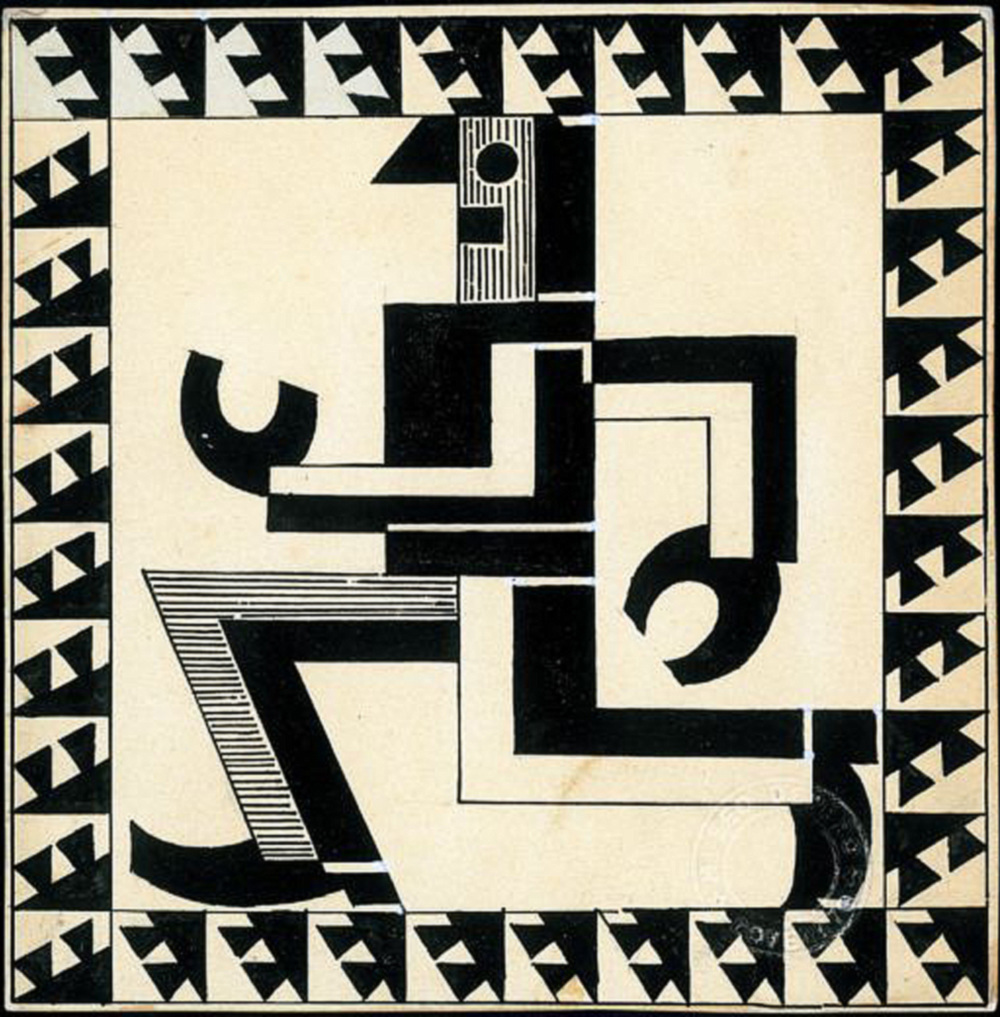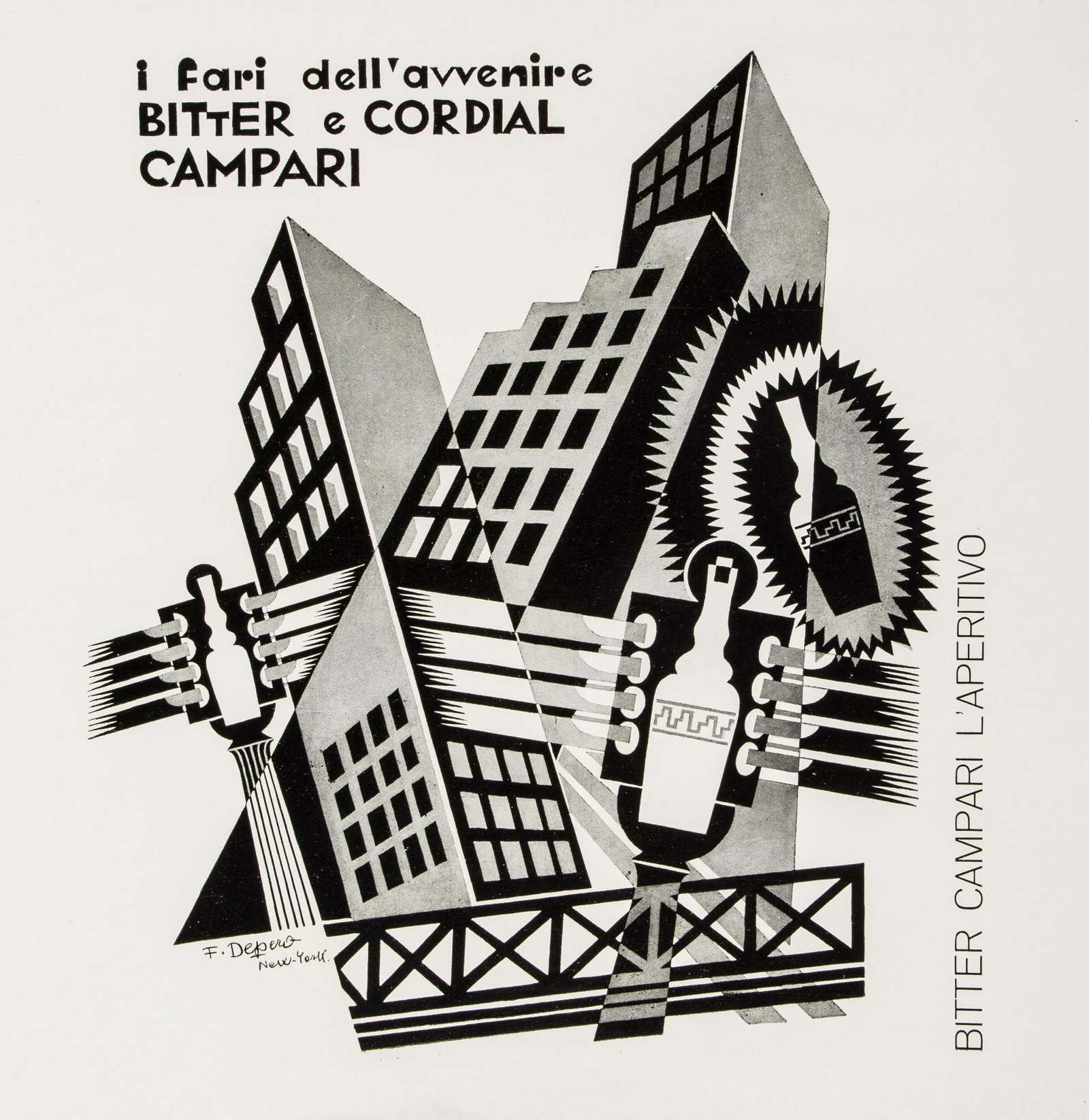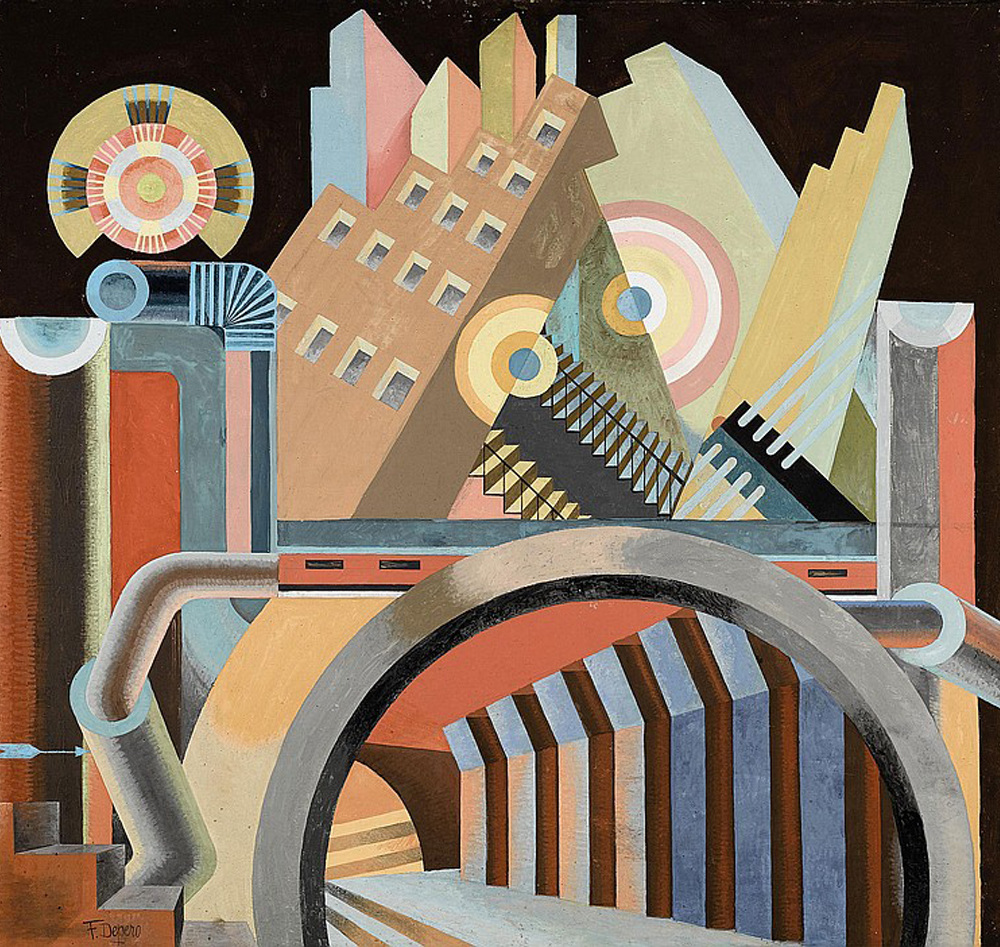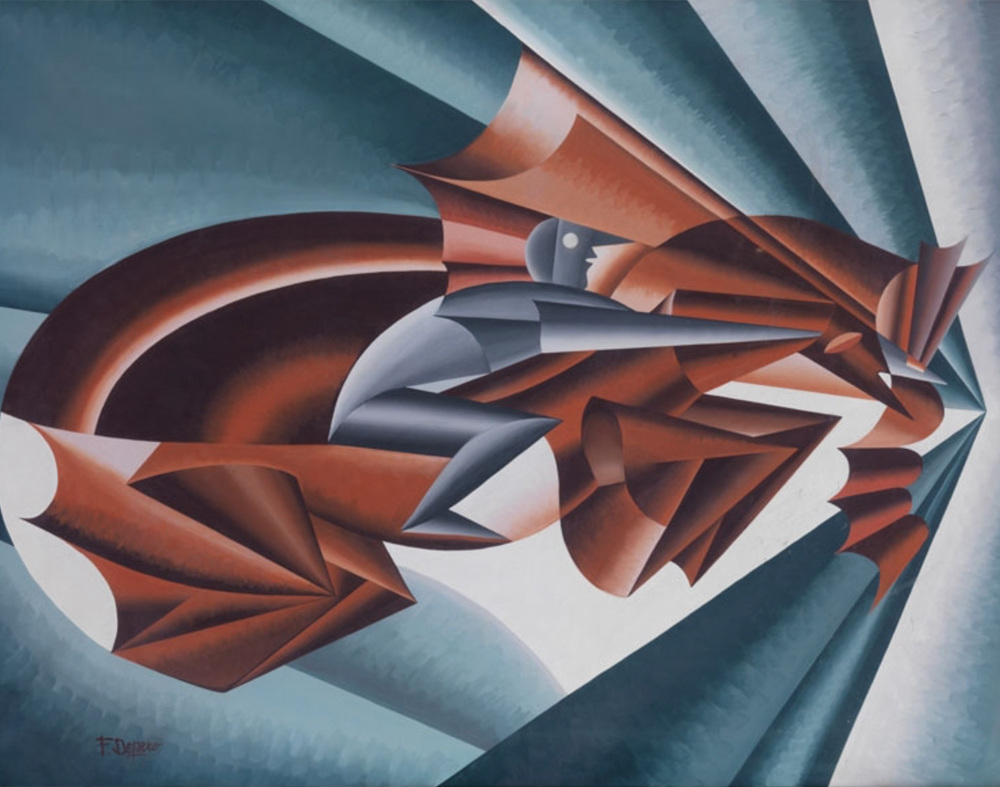fortunato depero
︎Artist, Futurism, Graphic Design
︎ Ventral Is Golden
fortunato depero
︎Artist, Futurism, Graphic Design
︎ Ventral Is Golden
︎ Ventral Is Golden
"A time will come when the eye of man will perceive colours as feelings within himself. To paint a human figure you must not paint it; you must render the whole of its surrounding atmosphere." - Umberto Boccioni.

Born in 1892, and inspired largely by the sculptures of Umberto Boccioni, Fortunato Depero became quickly infused with the Futurist Movement of the early 20th Century. An extremely talented and multifaceted artist, with works spanning the realms of painting, sculpture, collage, illustration, set and costume design, typography and advertisement, Depero and other Futurists became mouthpieces for the various changes brought about by new technological and political revolutions of Italy and subsequently the rest of Europe, that defined its character preceding World War I.
After releasing Depero-Dinamo Azari in 1927, a book known for being bound with industrial bolts, his talent for graphic design and advertisement during the mechanical revolution of art, culture and consciousness was clear. Depero moved to New York in 1928, becoming the first – and only – Italian Futurist to move to the United States. While in the United States he would design front covers for publications such as Vogue, Vanity Fair and The New Yorker, as well as designing one of his most iconic campaigns for Italian liqueur producer, Campari.
![]()
After releasing Depero-Dinamo Azari in 1927, a book known for being bound with industrial bolts, his talent for graphic design and advertisement during the mechanical revolution of art, culture and consciousness was clear. Depero moved to New York in 1928, becoming the first – and only – Italian Futurist to move to the United States. While in the United States he would design front covers for publications such as Vogue, Vanity Fair and The New Yorker, as well as designing one of his most iconic campaigns for Italian liqueur producer, Campari.



In today's connected, fluid yet seemingly fragmented and paradoxical cultural climate, where the negative impact of industry, advertising and capitalist systems are fulfilling their more destructive agendas, it isn't often that we hear the praises of industrialisation's consciousness raising effects upon the human psyche. In a convoluted way, however, this is what the Futurists’ thought.
Although they later became affiliated with the fascism of Mussolini, the Futurists’ love of disruption and progress paved the way for an extension of the human mind into new technological domains. Their conception of this idea, however, was not to stop at any cost, which led the movement to construct what some called “a church of speed and violence.” The later stage of Futurism embraced fascism as a kind of inevitability, pushing aside the idea of morality, arguing that innovation must never, for any reason, be hindered.
In a technologic age of introspection, where the very nature of the space between things is being brought to question, does this mechanistic metaphor of history begin to sound familiar?



“The Futurists‘ world was characterised by a new movement of mechanical domination over nature, on both psychological and sub-atomic levels.”



Provoked by the technological advances brought about by inventions such as the aeroplane and motorcar, and subsequent rise of the man-machine integrated Metropolis, the Futurists‘ world was characterised by a new movement of mechanical domination over nature, on both psychological and sub-atomic levels, where this new mechanical metaphor of nature had built itself directly into the atom.
"The period before 1914 saw a spectacular advance of capitalism, which was developing the productive forces at a dizzying pace. Europe and the USA were industrialising rapidly at the expense of agriculture, the proletariat at the expense of peasantry. Old ideas were crumbling. In the field of science the basis was being laid for a twin revolution, connected with relativity theory and quantum mechanics. The human mind was gradually penetrating beyond the world of appearance and discovering a deeper reality in the sub-atomic world, where the laws of the ordinary world of sense perception did not apply. The sensation existed that this was a new age, an age of progress in which the machine was king." - (Woods).
One positive aspect of the Futurists was their use of literary and typographic devices. Although they thought it would help disassociate Italy from the burden of it's history and rebirth the mentality of the country into the 'cult of the modern'; a new capitalist dream based on the integration of man and machine (which proved to be fatally conservative and short-sighted), these literary devices, such as those developed by Depero, liberated the mind from the confines of what the written, linear word-view allowed. This has always been a helpful tool in cultivating the ability to lift the mind out of an ‘escalator mentality’ induced by skyscrapers and metropolitan environments who’s long shadows cast obscurity over streams of consciousness and all subsequent ideas with the all-consuming ‘language of progress’.
In the world of Futurism the machine was God and although the human did not disappear entirely, it was just enough to be subjugated and alienated by the idea of absolute progress. In a similar sense, humanity continually ermerges and disappears into new technological relationships with nature that are predicated upon psychological and emotional responses as a way of situating the body inside a new model of the world. It is a kind of aperture through which the sentience of nature is either hidden or revealed in reflection to the psyche of the individual and the kinds of technology it is exposed to. It is perhaps a type of consciousness shaped by the conventions of linear history, despite examples to the contrary, such as the ancient Greek records of lost civilisations, the reasons for their downfalls, and the many other examples of anceint technologies and ‘out-of-place artefacts’ that seem to undermine ideologies of technological and cultural superiority.
It is an interesting phenomena of human pathology to use metaphors of new technology to describe reality in such a way that it falls outside of the effects of history, or as something seperate to the earth itself, as a kind of self-realised product of purely modernised thought, as opposed to arising from within an atmosphere of a dominant technology or culture.
"The period before 1914 saw a spectacular advance of capitalism, which was developing the productive forces at a dizzying pace. Europe and the USA were industrialising rapidly at the expense of agriculture, the proletariat at the expense of peasantry. Old ideas were crumbling. In the field of science the basis was being laid for a twin revolution, connected with relativity theory and quantum mechanics. The human mind was gradually penetrating beyond the world of appearance and discovering a deeper reality in the sub-atomic world, where the laws of the ordinary world of sense perception did not apply. The sensation existed that this was a new age, an age of progress in which the machine was king." - (Woods).
One positive aspect of the Futurists was their use of literary and typographic devices. Although they thought it would help disassociate Italy from the burden of it's history and rebirth the mentality of the country into the 'cult of the modern'; a new capitalist dream based on the integration of man and machine (which proved to be fatally conservative and short-sighted), these literary devices, such as those developed by Depero, liberated the mind from the confines of what the written, linear word-view allowed. This has always been a helpful tool in cultivating the ability to lift the mind out of an ‘escalator mentality’ induced by skyscrapers and metropolitan environments who’s long shadows cast obscurity over streams of consciousness and all subsequent ideas with the all-consuming ‘language of progress’.
In the world of Futurism the machine was God and although the human did not disappear entirely, it was just enough to be subjugated and alienated by the idea of absolute progress. In a similar sense, humanity continually ermerges and disappears into new technological relationships with nature that are predicated upon psychological and emotional responses as a way of situating the body inside a new model of the world. It is a kind of aperture through which the sentience of nature is either hidden or revealed in reflection to the psyche of the individual and the kinds of technology it is exposed to. It is perhaps a type of consciousness shaped by the conventions of linear history, despite examples to the contrary, such as the ancient Greek records of lost civilisations, the reasons for their downfalls, and the many other examples of anceint technologies and ‘out-of-place artefacts’ that seem to undermine ideologies of technological and cultural superiority.
It is an interesting phenomena of human pathology to use metaphors of new technology to describe reality in such a way that it falls outside of the effects of history, or as something seperate to the earth itself, as a kind of self-realised product of purely modernised thought, as opposed to arising from within an atmosphere of a dominant technology or culture.
Although the Futurists fell victim of this, their absurd poetics related directly to the public understanding of the Theory of Relativity, as it became entangled in the formalism of a new industrial complex that was mistaking ideas of speed and chaos for perfection and progress.
One of the leading members of the movement, Umberto Boccioni, once wrote that "on account of the persistency of an image upon the retina, moving objects constantly multiply themselves; their form changes like rapid vibrations in their mad career. Thus a running horse has not four legs, but twenty, and their movements are triangular."
Rather than perceiving an action as a performance of a single limb, the Futurists viewed action as the convergence in time and space of multiple influences. "The motor bus", Boccioni continued, "rushes into the houses which it passes, and in their turn the houses throw themselves upon the motor bus and are blended with it."
One of the leading members of the movement, Umberto Boccioni, once wrote that "on account of the persistency of an image upon the retina, moving objects constantly multiply themselves; their form changes like rapid vibrations in their mad career. Thus a running horse has not four legs, but twenty, and their movements are triangular."
Rather than perceiving an action as a performance of a single limb, the Futurists viewed action as the convergence in time and space of multiple influences. "The motor bus", Boccioni continued, "rushes into the houses which it passes, and in their turn the houses throw themselves upon the motor bus and are blended with it."
"The motor bus rushes into the houses which it passes, and in their turn the houses throw themselves upon the motor bus and are blended with it." - Umberto Boccioni.




Depero also dipped into the word of fashion design.
Fashion, initially as a verb or 'a manner of doing something', is what separates it from most other mediums as an art form that directly affects the mind by being placed upon the body. It becomes a kind of social ritual: a medium in which the human body dwells and emerges as an interface between the internal message and the external reaction.
For Depero, the subversion of the waistcoat acted as the space suit of the Futurist's exploration into the new techno-superior dinner party of the hyper industrial, transhuman dimension.
Corporations in our current culture for example, also present us with the desire to transcend social class and even to acheive broader immaterial concepts such as ‘equality’ through an extension provided directly through material products. The illusion is nothing new. The hope of Depero's waistcoats were a new form of thinking within his social circles, in revolt of the petite bourgeoisie, who stood in the way of extending the reach of humankind, allbeit, in the end, at a wider cost to human freedom and the enovironment.
Machinery, technology, information and fashion, have of course many useful applications, however, it is the mental processes hidden inside expressions of technology that contain the seeds of potential change relating to philosophical and humanitarian ideas such as ‘equality’ and ‘progress’.

Do these patterns of technological and cultural superiority now represent themselves within an age of instant communication as opportunities to transcend the once coveted notions of indentity, nationality, progress, wealth, and so on, by readdressing the nature of their origin and cultural context - before standing armies, before slavery and property, before warfare, before phonetic alphabets, before monotheism, before, before, before. And is this where the old idea of the future is taking us, because the secret faith of the twentieth century was not modernism, like the secret faith of the twenty first century is nostalgia for the archaic, nostalgia for the paleolithic and a return to ‘the first time’.
Ironically, the facsist leader of the Futurist movement, Filippo Marinetti, often declared that history should give way to strength, speed and the power of the machine, yet to avoid the obviously negative connotations of these words we must also be mindful of his notion that “an image must be a synthesis. It is not only what one sees, but also what one remembers.”
Ironically, the facsist leader of the Futurist movement, Filippo Marinetti, often declared that history should give way to strength, speed and the power of the machine, yet to avoid the obviously negative connotations of these words we must also be mindful of his notion that “an image must be a synthesis. It is not only what one sees, but also what one remembers.”






Further Reading ︎
Depero, Pinterest Board
Vests by Depero, Italian Ways article
Technical Manifesto of Futurist Painting
Italian Futurism, Introduction
Futurism and Fascism, Alan Woods